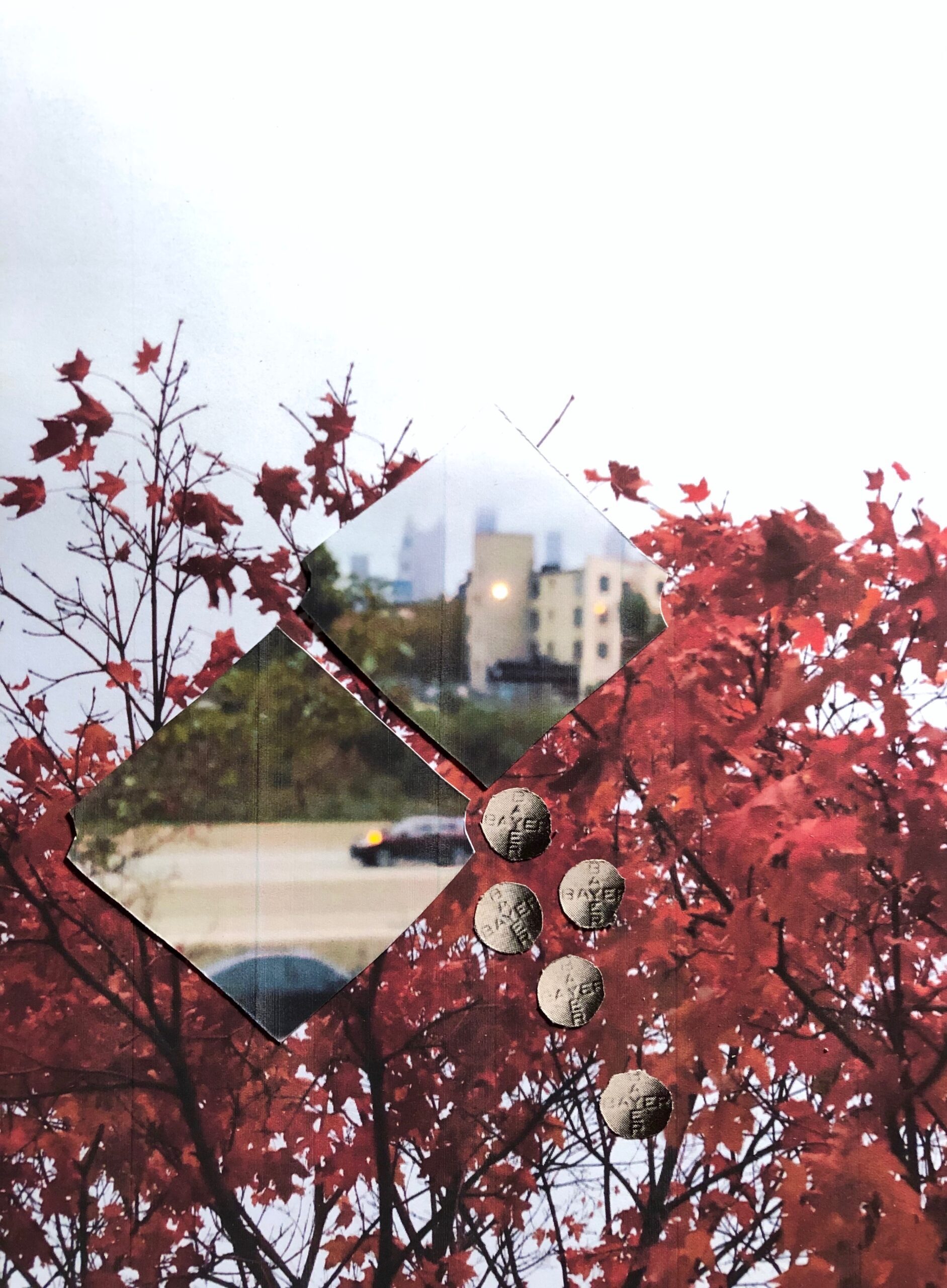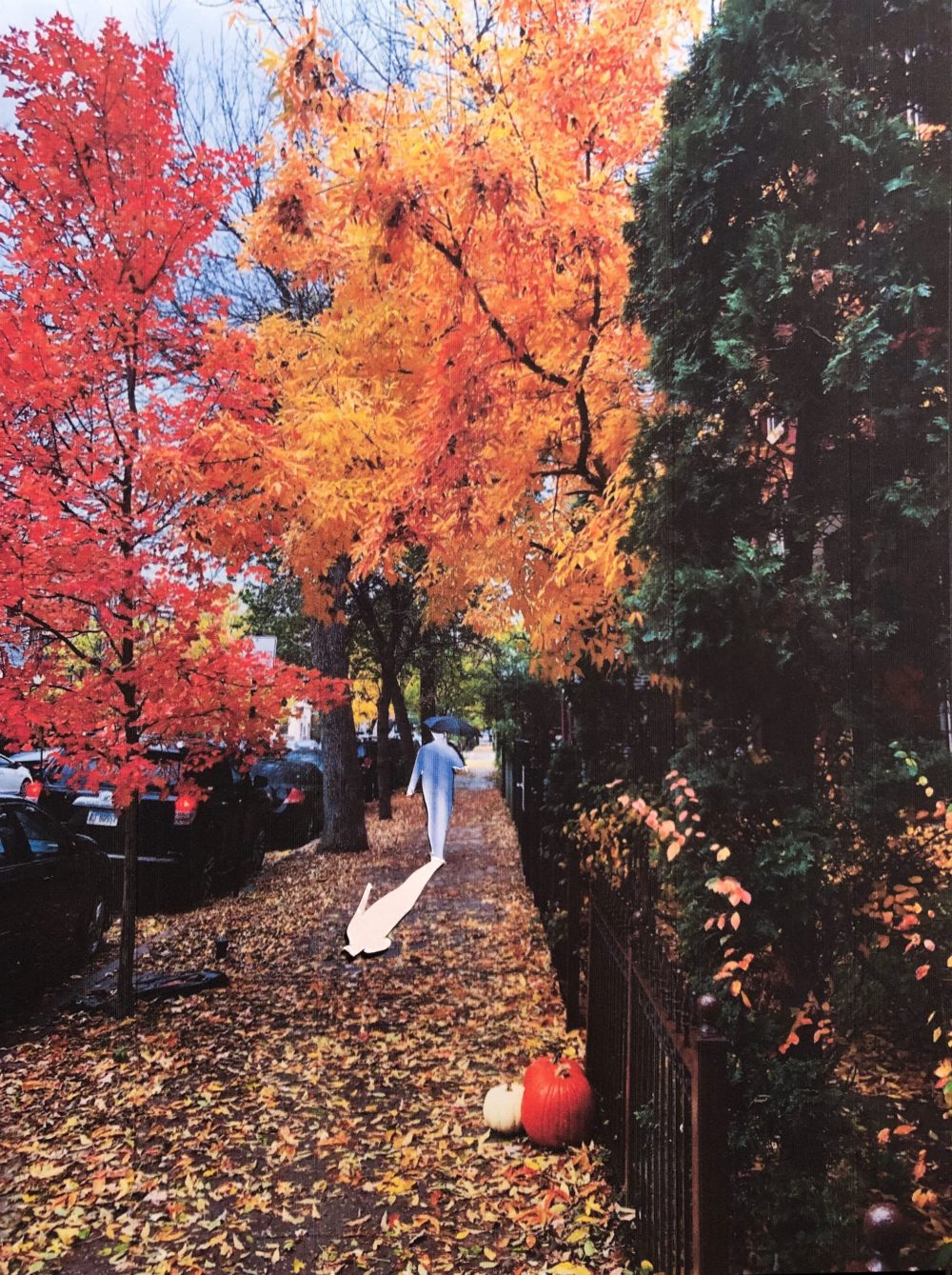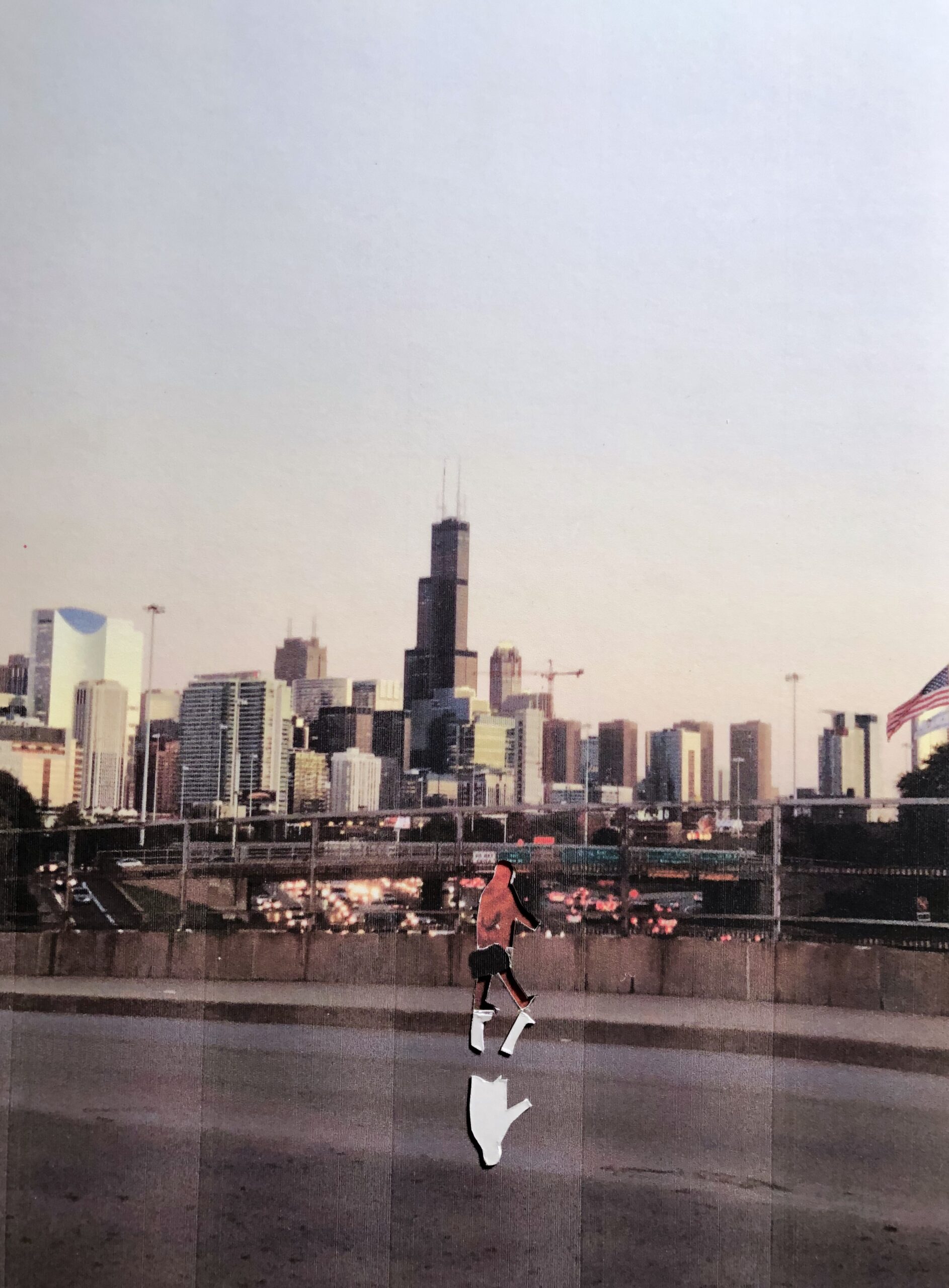It’s the first crisp autumn morning of the year. Not crisp but cool. The weather app on my phone says fifty-eight degrees, which, in the Midwest, is almost crisp. Outside my window, the Chicago wind blows—not rustles but rips—through the trees.
I’m suddenly self-conscious of that description. Why do I care if it’s showing enough or any good? Why the pressure to write something that delights, attracts, baits? Why now? Especially now, this morning of all mornings. This Saturday morning, when the sun’s just broken through the clouds, when what I’m really thinking about is how to end my life.
Physicians come to mind, the ones who argue, vehemently, that there’s no such thing as mental illness, that we as a society have created crutches for people, that the medications have caused what we call illness, that we’re over-diagnosed.
I wish those doctors were with me now, sitting on the beige carpet in my bedroom, watching me gather my bottles of pills, determining which would be the most effective and cause the least pain. What would they say? Would they ask me why I want to die? Would they care? Would they shrug when I give them a simple answer: After fifteen years, the pain’s become too much.
I forget what I’m writing. I cry until the screen blurs. The pills are waiting. Thoughts race. Who will find me? What’s on the other side of death? (Nothingness, my atheist upbringing tells me.) Then a disconnect. People describe suicidality as linear. There’s a plan. An execution. But I randomly think about the Emmy Awards, which I didn’t watch but heard about, and that Felicity actress who didn’t want a marriage proposal. A motorcycle roars past my window. I imagine the man driving dressed in yellow leather, though I don’t know if yellow leather exists. I think of cantaloupe and honey. I think of the many, many family members and colleagues and friends from whom I’ve hidden my illness for nearly two decades. Then comes the images of my mother, my father, my sister, each of whom has tried and tried to help me, each one, individually, a support like no other.
Which is to say that I’m lucky beyond measure. I pass men (usually) and a few women downtown outside Macy’s or circling State and Elm, people who have the illness inside them, too—powerful and frightening—but they have no care, none of the privilege I’ve had.
Which is also to say that this illness is fierce. Monstrous. And for me at this moment feels untreatable. Hopeless. Most of the medications I’ve tried don’t work on my body. I have the kind of body that experiences side effects worse than the symptoms themselves.
The day ahead could go in two directions: I could follow my Saturday routine—write, workout, eat lunch, write, grocery shop—or this could be the day I end it.
My gym bag sits on my bed. In it is the black sweatshirt I packed to work out in. I think of the young woman who sold me the sweatshirt—about twenty years old with kinks in her hair and kind eyes—the sweatshirt meant to raise awareness for suicide prevention. On the front it reads, It’s okay not to be okay, a lifeline to the hopeless and helpless, the SIs (those suffering from suicidal ideation) wandering within our overprogrammed, pumped-up, hungry-for-success culture.
I bought the sweatshirt a week ago at an art/activist installation in a small storefront downtown. There stood one hundred and twenty one mannequins, each wearing a t-shirt or sweatshirt identical to the one in my bag. The installation was created by the organization Hope for the Day. When I entered, crowding in among mannequins of different races, the curator said, “The installation is meant to make you uncomfortable.” I was uncomfortable.
I am uncomfortable. One hundred and twenty one Americans die by suicide each day (not “commit suicide” because it’s not a crime, not anymore, though in some states it’s still an unwritten “common law crime”). If we were to slot the statistics evenly, it comes out to one suicide every forty seconds.
I open the bag and pull out the sweatshirt, look at it. Remember buying it. I pause. The sweatshirt gives me pause, stops me, makes me want to help the other one hundred and twenty one trying to decide if they should push through, take support, find support, call a family member or friend, call the National Suicide Prevention Lifeline: 1-800-273-TALK.
It’s not that easy. It’s never that easy.
For the next three days, my thoughts spin. Sometimes, they shout. Sometimes, they’re viciously “helpful,” offering new suicidal thoughts—other methods, different timing, new locations.
I don’t listen. I stick to my plan, convinced it will finally rid me of the hollow black in my stomach, my soul thinning, the shakiness, the fear when I wake, the crush in my chest that comes from wanting to be erased.
On my desk is the pad of paper I’ve been using to make notes for my novel. I flip to a blank page, a page so fresh it stares up at me. It waits. Only a third of people who die by suicide leave notes. For me, a note feels necessary. I want it in writing, so nobody feels blame or guilt. I address the note. I keep it brief. I end with a postscript asking them to wipe my computer clean and destroy all hard copies of my writing.
I leave the house with my pills in my bag. My plan is clear, lucid. I am clear, lucid. It’s the right time. No one is waiting for me. No one needs me.
The plan must be executed outside. I have to risk a stranger finding me because I could never put my family through that. It’s not fair to anyone, but it’s the way it has to be.
I push through the front door of my apartment and feel a shift. Blue sky, yellow sun. Pedestrians. Down the block comes the little white dog I dislike and its owner who I’ve never spoken to. The crackling grind of iron balconies being soldered on the apartment building across the street. The scene, the shift in scene—and this is the strange thing about suicidal ideation—drains me of momentum.
A friend of mine likes to say, “We’re all a little crazy.” No. Simply, no. Maybe if you go by the extensive list of disorders and vague criterion in the American Psychiatric Association’s all-embracing and controversial Diagnostic and Statistical Manual of Mental Disorders, Fifth Edition (DSM-5), which now clocks the number of disorders at one hundred and seventy-two, or if you go by the media’s glib clichés and mottled statistics, spewing rhetoric that the number of American adults with a mental illness is anywhere from eighteen percent to twenty-six percent. Sometimes it’s one in five; other times, one in twenty. Forty-four million. Twenty-eight million. The imprecise terminology is partly to blame, how they muddy terms like mental disorder and mental illness. Even health professionals use them interchangeably. But Serious Mental Illnesses (SMIs)—schizophrenia, bipolar disorder, and major depression—are different, somewhere between three and six percent. We are the ones most in need of care, who lose funding and programs to the eighteen percent, the twenty-six percent, “the worried well.”
I’m an SMI but I’m also insured, which is to say that I’m lucky beyond measure. I have a psychiatrist. He’s a thin rope I see every week who makes me believe some medication will help. The shift and the thin rope make me show up for our scheduled appointment. I get there and feel like a coward—as afraid to die as I am desperate to do it.
I tell him some but not all. Yes, I cry. Psychic pain, physical exhaustion, a sense of failure.
I mention the pills in my bag: big mistake. Once it’s out, you can’t take it back. Once it’s out, mission aborted, mission unfulfilled. I’ve lost my agency, my power to choose. He’s a good listener, a brilliant doctor. The look in his eyes is one of sincere but professional concern. His tone of voice is measured, especially when he keeps repeating how alarming he finds my behavior, that I need to be somewhere I can be watched and safe.
He can, it seems, hospitalize me against my will. It’s not that easy. It’s never that easy. But I assume he’s right, has my best interests in mind, and I go.
The security guard at the emergency room takes my belongings, catalogues them, and locks them up—pills inside. She’s genuine, almost apologetic in her desire to help me. I want to stay with her, but she directs me to sit in a chair with the other SIs.
“Sitters” watch us to make sure we don’t try to leave. We aren’t referred to by name but simply as SIs. I’d like to think they care, and maybe they do, but the reality is that if we bolt— we’ve been admitted as suicidal with wrist bands to prove it—the hospital’s liable.
The SI next to me rubs his stubble. He raises his chin, not like he’s casing the joint, but just checking it out. I get the feeling he’s been here before. His flannel shirt is clean, his khaki pants dirty, his Timberlands untied.
The nurse in dark blue scrubs asks him rote questions: Is he suicidal? Has he taken anything? Has he cut himself? Does he hear voices? Is he seeing things that aren’t there? Is he homeless? He answers: Yes, no, no, hesitant yes, no, yes. Does he have any allergies? Yes (with authority) Haldol.
It’s pretty much impossible to be allergic to Haldol, but it’s a smart move on his part. Haldol is an antipsychotic that’s the stuff of nightmares and One Flew Over the Cuckoo’s Nest. It’s potent, turns you into a zombie—the way it makes you walk is still referred to as “The Haldol Shuffle.” But it’s quick to sedate people agitated to the point of hurting themselves or others.
The SI beside me knows the drill. He knows how to handle himself.
I don’t. I don’t know the severity of what’s going on, don’t know what’s happening. All I know for sure is that I’ve missed my chance and have no control over what happens next.
They take my clothes and put me in a gown. I’m given a hospital bed in a room with a curtain that can’t be drawn so the three security guards and the sitter can watch me and two new, uninsured male SIs who’ve arrived, one in Velcro restraints because he was brought in by the police.
After an hour and fifteen minutes (I am staring at the clock), a nurse comes in. She looks so young; she could be thirteen. She takes my vitals and struggles to get the vials of blood they need. The doctor, she says, will be in soon to finish my medical check. Then, finally, a psychiatrist will see me.
There was a time when I tried to treat my illness without medication. Yoga. Meditation. St. John’s Wart. A vegan diet. Tryptophan. Fasting. The absurdity of it astonishes me. Without the drugs in my system at this minute, I’d be dead.
Which isn’t to say that some psychiatrists don’t overprescribe or some pharmaceutical companies aren’t unethical in the selling of psychiatric medications. One of the more cited examples of questionable practices is by Eli Lilly, who marketed Prozac, the depression “wonder drug” in 1987. Despite concerns from its own researchers, the company failed to warn of suicidality as a potential side effect in children and young adults. In 1990, Lilly was sued for gross negligence. The FDA responded that a causal relationship couldn’t be proved but later issued “black-box warnings” for suicidality in the taking of antidepressants among young adults. In 2001, Lilly lost the patent. In 2002, the company was accused of sending trials of “Prozac Weekly,” which was still under patent, to potential patients through the mail.
But disparagers of psychopharmacology tend to reinforce the stigma of mental illness, especially for SMIs. The media’s reporting of psychopharmacology often reinforces a culture of shame around psychiatric medications and those with mental illnesses who rely on them. Some critics claim that psychiatric medications are ineffectual at best and harmful at worst (Irving Kirsch, Robert Whitaker, and Daniel Carlat). One, while he was alive, even went so far as to insist that there’s no such thing as mental illness.
A woman I can’t see because she’s down the hallway is brought in. Her voice enters first. Screaming incoherently. Or coherently, and I just don’t understand. It’s the sound of someone on the street, someone you might pass and think, fucking crazy or batshit crazy or lunatic, automatic thoughts we don’t want to have but do because underneath them is, Thank god that’s not me.
The woman screams. Her words are a jumble of gasps and curses and “get ya hands off me” and “someone’s gotta help.”
The doctors in the station across from me discuss her, loudly. We can all hear. They debate the options for treatment. The woman’s screams turn almost to howls. One doctor says something about an injection. Another confirms: Haldol and Ativan.
The woman screams. Within ten minutes, all is quiet again.
Four hours later, I’m still waiting to see a psychiatrist. The two men and the sedated woman are ahead of me in line. Later, I’ll learn that there were a total of fourteen people waiting to see a psychiatrist that day.
The press often likes to refer to “the current mental health crisis in America,” but America’s mental health system has always been in crisis; it has never provided adequate care for people with mental illnesses. In the nineteenth century, “lunatic asylums” were inhumane. Patients were chained to walls, left unclothed and sitting in their own feces, subjected to ice baths and electric shocks (not Electroshock Therapy, an often-effective medical treatment, just electric shocks). During the first part of the twentieth century, psychiatric institutions—though reformed—weren’t much better: lobotomies, forced sterilizations, strait jackets, overmedication.
It wasn’t until 1955 that the Mental Health Study Act called for an examination of the country’s mental health system. The answer seemed to be deinstitutionalization. In the 1960s and 1970s, mental hospitals were closed en masse and patients were “sent home,” though few had one. Seventy percent of the country’s psychiatric facilities were closed. The idea was that community centers and prescription drugs would be enough to care for people with severe mental illnesses. But those community centers were never opened—the Reagan administration saw to that. Mental health funding was slashed every year until people with mental illnesses were living on the street or in jails and receiving inadequate or no treatment. The Cook County Jail, for instance, had become the largest mental health facility in the country.
An hour later, the psychiatrist still hasn’t shown. How many more hours will it be? When—if—he finally comes, he’ll evaluate me. He’ll decide if I’m a danger enough to myself to be admitted.
Then I find out there are no beds here, no beds at any of the closest four hospitals with psych wards in the Chicago area. The two men without insurance, assuming they’re admitted, will be transferred to the state hospital. I don’t know where I’ll be sent.
They sleep. I stare at the clock, try to figure out how to get out of there before I see the psychiatrist. Once I do, he can force me to stay. Stay where? No beds. No resources. Where is the help in that?
Now, home, at my desk, typing this, I live in a world of acronyms—PHP (partial hospitalization program), IOP (intensive outpatient program). And treatment lingo—CBT (Cognitive Behavioral Therapy), DBT (Dialectical Behavioral Therapy), ACT (Acceptance and Commitment Therapy). I “process” “in group.” I talk and listen to the other patients (or clients, depending on the therapist and treatment center) in group therapy sessions. I listen, mostly to other people of all races and genders and professions and classes, seated on too-soft couches or hard plastic chairs. They say things I feel but can’t name, can’t pinpoint, can’t process. In my pocket is a handout of a “Feelings Wheel,” a drawing of a circle sliced into slim pie pieces, each with its own emotion: bored, sickened, worried, helpless, hesitant, affectionate, connected, curious, caring. There must be a hundred of them, many of which I never think about. I’m either fine or not fine, okay or not okay, good or not so good. But doing “okay” or “good,” it seems, is not naming an emotion. So, I study the wheel and its emotions—puzzled, repulsed, envious, safe, satisfied—and consider which have pulsed inside me without my noticing.
On my phone are apps to help me monitor my moods and track the number and intensity of my SIs. Days pass without any. Not one. It’s a victory. But sometimes—and I know I’m not supposed to say this—I miss them, those ideations. They were so familiar, so much, it seemed, a part of me. Just a coping mechanism, one of the therapists says. And I wish he hadn’t because it dilutes their power and makes them fade even more.
Not always. Because it’s not that easy. It’s never that easy. So, I show up to my appointments and attend each session and get my blood tested for my medication levels, and I listen.
As I cross the Michigan Avenue Bridge, the wind bracing in the already-too-cold, I carry the handout of the Feelings Wheel—folded, creased, already wearing at the edges—in my pocket. I pass a man mumbling to himself. He has on a soiled coat and a tote bag around his neck so it hangs down in front of his chest like an albatross. His steps are heavy, his eyes glassy but not from drink or illicit drugs. He talks animatedly to the air, to the voices in his head, perhaps to someone I can’t see, someone who must say something hilarious because the man stops and leans over with laughter. He doesn’t ask the cell-phoned tourists, the ones smiling in front of the lit-up Wrigley Building, for money. He’s busy, his mind creating his reality.
Maybe I shouldn’t assume he’s one of us, that he’s someone with a serious mental illness, or that he doesn’t have insurance and access to care, but I do. And it reminds me again that I’m one of the lucky ones. I get to go to a version of those community centers that politicians promised almost fifty years ago but which never materialized, not for everyone with a mental health condition. I get to show up for appointments and sessions and have my blood levels checked and listen to others. I get to go home.
***
Rumpus original art by Cyrus Finegan.
***
The National Suicide Prevention Lifeline offers free, confidential crisis counseling twenty-four hours a day, seven days a week, three hundred and sixty-five days a year. You don’t have to be suicidal to call (1-800-273-8255). The Lifeline also offers services for people who are deaf or hard of hearing (1-800-799-4889) and people who speak Spanish (en español: 1-888-628-9454). People who are transgender can also call the Trans Lifeline (U.S.: 877-565-8860; Canada: 877-330-6366). If you’re a journalist reporting on suicide, suicide prevention, or mental health and mental illness, you can find guides and resources to help you in your work at ReportingOnSuicide.org. This is a personal essay and represents the thoughts and feelings of its author first and foremost. Overall, we have tried to adhere to many of the suggestions at ReportingOnSuicide.org while editing this essay; however, we have also respected the author’s wish to communicate what it’s like to live with suicidal ideation to those who don’t experience it, which means we’ve included some material that might not be appropriate in a traditionally reported journalistic piece. – Ed.








